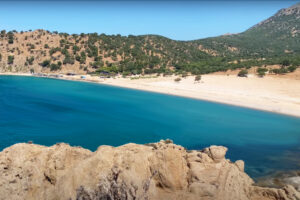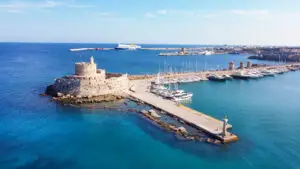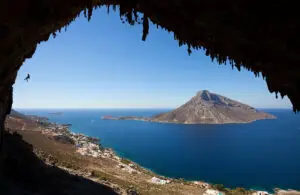
Samothraki Island Travel Guide
Samothraki island -wild nature, powerful energy, and a rare kind
Two tiny specks south of Zakynthos, the Strofades (Stamfani & Arpia) feel like a time capsule, monastic walls, a lighthouse battered by storms, and migratory birds swirling above emerald waters. Access is tightly controlled due to environmental protection and heritage conservation; sailing yachts usually admire from offshore in settled weather.
What: Two protected islets south of Zakynthos (Ionian Sea), famous for a medieval fortified monastery and rich birdlife.
Can I land? Often no. Landing and monastery entry typically require permission due to active protection & restoration.
Best way to see them: Offshore viewing from a yacht on calm days; consider ranger guidance and current notices.
Closest base: Zakynthos (Zante); pair with a South Ionian loop (Zakynthos–Kefalonia–Ithaca).
Best time: Late spring & September–October for calmer seas and fewer meltemi-type disturbances.
The Strofades lie roughly south of Zakynthos in the open Ionian Sea. The larger islet is Stamfani (with the monastery and lighthouse); the smaller is Arpia. They sit on major bird migration routes, which is why the area is a protection hotspot.
Protected area: Seasonal restrictions can apply to landing, walking ashore, drones, and nighttime approaches.
Monastery (Fortress-Monastery of Strofades): Access is usually restricted; damage from past storms/earthquakes means ongoing preservation work.
Respect wildlife: No loud music, no spotlighting birds, keep distance from nesting sites.
Check notices: Before planning a detour, confirm current rules with the Zakynthos Port Authority or the local marine park announcements.
⚠️ Plan B mindset: Weather, swell, and conservation closures frequently make Strofades a “look but don’t land” target. Build alternatives into your day plan.
Option A — Offshore Viewing (most common): In fair weather, approach from the north on a daylight window, maintain a respectful stand-off distance, observe islets and monastery walls, then continue your passage.
Option B — Guided / Permit-based Visits: If and when allowed, secure written permission and follow ranger instructions.
Option C — The Smart Alternative: Spend the saved time exploring southern Zakynthos coves or the Keri area, and add a cultural stop in Kefalonia or Ithaca.
Exposure: Little all-round shelter; swell wraps. Treat as a fair-weather fly-by.
Depths & bottom: Variable; do not rely on satellite color alone.
Night approaches: Avoid—navigation hazards + wildlife sensitivity.
Comms: Monitor local notices (VHF / port authority).
Fuel & water: None on the islets—plan from Zakynthos/Kefalonia.
May–June, Sept–Oct: Calmer seas, milder heat, good visibility.
July–August: More traffic and stronger winds/swell; conservation rules unchanged.
Winter: Unsettled weather; not recommended for leisure craft.
A fortified Byzantine-era monastery (later additions under different powers) stands on Stamfani, built like a castle to withstand pirates and storms. Its remote placement helped preserve rare manuscripts and traditions. Modern restoration aims to stabilize the complex for future generations.
The Strofades are an important migratory bird station. You may spot raptors and seabirds riding thermals above stark limestone ledges. The seabed hosts Posidonia meadows—keep your anchor off sensitive areas anywhere in the Ionian.
Zakynthos (Zante): Blue Caves, Keri, Marathonisi, southern coves.
Kefalonia: Assos, Fiskardo, Melissani.
Ithaca: Vathy, Kioni—Homeric scenery with quiet anchorages.
3 Days (Zakynthos focus): Zakynthos south coast → (Weather window) Strofades offshore pass → return via Keri & Marathonisi.
5 Days (South Ionian taste): Zakynthos → Kefalonia (Poros/Skala) → Strofades pass → back to Zakynthos.
7 Days (Classic loop): Zakynthos → Kefalonia (Sami/Assos) → Ithaca (Kioni) → Zakynthos → Strofades pass → Zakynthos.
Harbors & Services: Use Zakynthos as your provisioning and fuel hub.
Permits: If any landing is provisionally allowed, obtain explicit permission in advance; carry documents on board.
Safety: Offshore, maintain lookout for reefs and overfalls; reassess if swell builds.
Are the Strofades inhabited?
Not in the usual sense; there is no tourist village, and access is restricted.
Can I visit the monastery?
Generally no without formal permission; rules change with restoration phases.
Is anchoring allowed?
Treat the area as look-don’t-touch unless official guidance states otherwise.
What’s the safest way to include Strofades?
Choose a calm, daylight weather window for an offshore pass, then continue to Zakynthos/Kefalonia.
What makes Strofades special?
A rare mix of fortress-monastery heritage and bird migration haven, set in dramatic isolation.
What charts should I carry?
Use up-to-date official charts + local pilot info; satellite imagery is not a substitute.
When is the sea state most forgiving?
Late spring and early autumn.
Are there facilities?
No—plan water, fuel, and waste strictly from Zakynthos/Kefalonia.
Can I use a drone?
Usually prohibited due to wildlife sensitivity; check current notices.
What are good alternatives if it’s rough?
Zakynthos’ south coast and Keri area are excellent back-ups.

Samothraki island -wild nature, powerful energy, and a rare kind

Largest of the Dodecanese Islands: A Sailor’s Deep Dive into

Contact Us Now to Create Your Dream Sailing Itinerary [email protected]